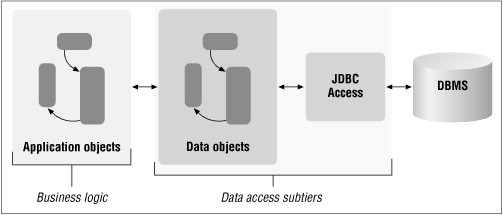Remote Database Applications
As we alluded to earlier in the book, client-server applications are often broken down into different levels, or tiers, to use the current vernacular. A typical application breakdown involves three tiers: user-interface functions, application objects, and data access. Up until now, we’ve mostly been discussing ways of distributing the application logic across the network, using distributed objects or some form of message passing to allow elements of the core application to lie on remote hosts. In this chapter, we’ll discuss the options available for implementing the data access level of a distributed application.
The data access tier of a multitiered distributed application can be divided into two subtiers, as shown in Figure 7.1. First, an interface must be established between JDBC and the actual DBMS holding the data. A set of data objects representing the concepts in the database can then be defined; these objects serve as an interface from the application-level objects to the data in the database. These data objects interact with the DBMS through the JDBC interface to perform operations on the low-level data that they represent. The application-layer objects interact with the data objects to query and update the data.
 |
JDBC Driver Configurations
Before you can use the JDBC API to engage in transactions ...
Get Java Distributed Computing now with the O’Reilly learning platform.
O’Reilly members experience books, live events, courses curated by job role, and more from O’Reilly and nearly 200 top publishers.

